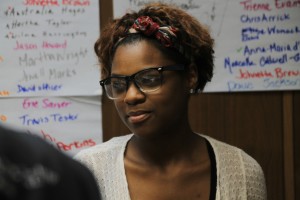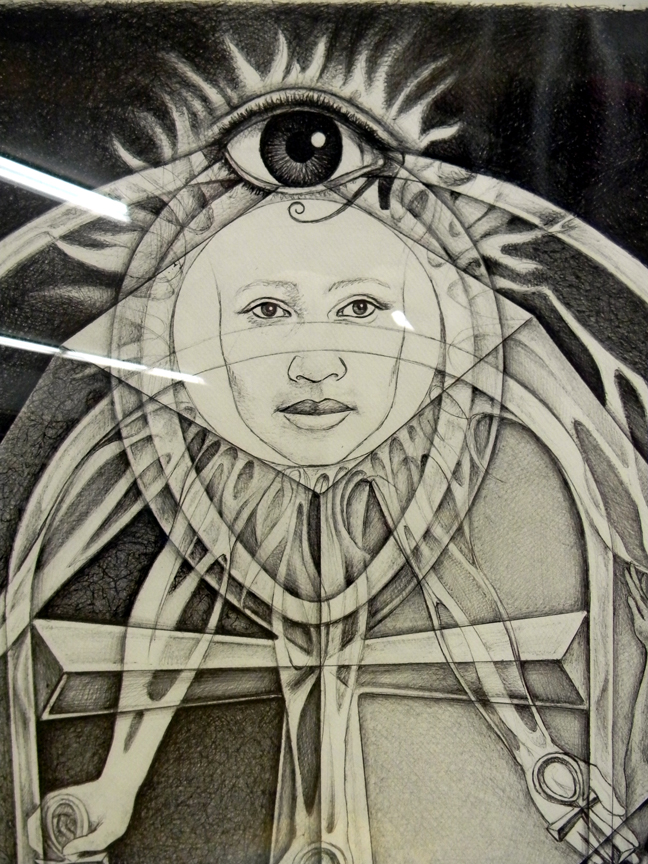Continued from Part I
We Eat
The meal began naturally. After a prayer led by Joey, we eagerly began to pass dishes and fill our plates with delicious-looking and -smelling breakfast food: chocolate pancakes, scrambled eggs, crispy bacon. I was immediately impressed by the cooking skills in the family–each of the kids had made one of the dishes. Around the table sat the guests of honor, about 4 other Rovers, and two members of the kids’ family: Connie, their mother Connie and their older sister Katrina.
I followed the conversation, observing more than I talked with my eyes, ears, and camera. Often wary of being too “outside” of exchanges in community, especially where I’m clearly of a different demographic, I felt OK with this role since all of the Rovers either knew me or that this was my main function in the project–and, Connie and Katrina simply didn’t seem too bothered or uncomfortable with me doing just that. I also felt justified in that this was my first time witnessing first-person this particular kind of meal in practice.
Unlike the ones I’d first heard about through De’Amon, which brought people of the same gift, interest or passion together, this was a meal centered around naming the gifts and finding ways to support a particular person (or in this case, people). I’ve heard of this practice both through Broadway and other peers and groups, such as circle work in the alternative disabilities movement.
In all cases, something magical has emerged, which testifies to the amazing power of the simple act of acknowledging “what’s there”–ie. the good, the powerful, the whole and the inspiring–in another person, out loud and in front of others, and of opening space in that same conversation for what the person’s hopes and dreams are and exploring together what resources, relationships or ideas lay waiting within the friends, family or neighbors to support that central person to achieve their dreams.
So, I awaited the emergence of this “gifts” conversation with eagerness and curiosity. How would it be brought up? How would people react? I’ve initiated and been part of “gifts” conversations, but it was usually in a situation where everyone was already “in” for some kind of community-building experience. I was also curious about this being a meal centered around not just one but three people… How would there be time for it all? Would it dilute the “magic” by spreading out the focus to three instead of one?
Naming Gifts: a Radical Act
“Naming” is one of the other genius practices I’ve witnessed through Broadway–the act of intentionally celebrating the gifts, talents and good actions we see in our fellow human beings. Part of the five core practices emphasized in the RYC summers (“Name, Bless, Connect, Celebrate”), this idea of “Naming” is central to the work done at Broadway and those connected to its particular style of asset-based community building and, while seemingly small, has deep and far-reaching impact.
Again, there is a parallel here with business culture. In high-profile events or business settings, it’s customary to introduce people by their relevant title, skills, or connections. “This is Janice Smith, Executive Director of Blah-blah-blah,” or, “Have you met the Jim La-la, the famous musician?” This helps the person meeting them identify what value or potential use they may have for them in their lives or work.
But, when functioning outside of these kinds of settings, how often do we acknowledge and celebrate each other’s value?
After my exposure to the culture of constantly naming gifts around Broadway, I realized: Not much! Usually, we share a person’s name and, maybe, who they know that someone else may know. The rest, we let them figure out between themselves–or not. People who are natural connectors tend to do it all the time, but at Broadway, an actual culture has been intentionally built around making this common practice.
Yet, when we intentionally name another’s gifts in social, community and neighborhood contexts, we are doing an incredibly powerful thing.
We are making the invisible visible–scratching a window into the dull paint of scarcity thinking that coats our view of ourselves as others in modern society as dependent upon experts, institutions, professionals, charismatic leaders, or sometimes just “someone else” for the solutions to our personal and our collective problems, or for creating the kind of future we wish to see. Schools are responsible–and (ideally)–best-equipped for educating our children. Doctors, nutritionists, and health organizations are responsible for our health. Counselors will fix our minds and marriages; politicians our floundering social and economic systems.
On one side, there is energy and rhetoric in activist environments (where I’ve also spent a lot of time) about regaining citizen power and control over our reality and our future through organizing and voicing demands for change. Yet, from my experiences in and continued observation of these environments, there is a hollow, gaping hole between rhetoric and practices which infuse energy, joy, and a deeply rooted belief in our and our neighbor’s personal power to “be the change” of which we speak.
By boldly acknowledging in open speech what “is there”–what spark of innate creativity, cultivated capacity or impressive skill–in ordinary spaces of interaction with one another, we go from wishing for a better world in which our wishes are within our grasp to making the materials and relationships for this world to happen visible, tangible and suddenly in the hands of our friends, neighbors, church-mates… or whatever seemingly random new person we may have just met.
This is particularly powerful when we or those we’re introducing have the misfortune to be recipients of society’s more damning naming practice–that of labeling folks by their deficiencies and problems. As I first heard it explained by John McKnight, co-founder of the ABCD Institute, if you go to a little town he knows in Michigan, you will see a man and someone will tell you, “That’s Jerry. He’s the best builder in town.” If you went to the hospital across the river, or the social service agency, what they would tell you about Jerry is totally different–that he is an alcoholic with a bad heart problem.
The traditional wisdom of community, while never blind to these weaknesses or problems we all have (I’m practically blind without my glasses and quite rich in other deficiencies as well), knows that that is not the most important information about a person–because, simply, you can’t DO anything with someone’s empty half! Jerry’s building expertise is useful to me and my neighbors… his alcoholism is not. Today, as neighboring and citizen action has given way to disconnect and the rise of professionalized functions who base their existence upon identifying, categorizing, and fixing specific groups of people, the naming of emptiness has also prevailed, to the point that it’s socially acceptable and common in our social sphere to throw around others’ emptiness labels–“alcoholic,” “disabled,” “ADHD,” “homeless,” “poor,” etc.
The result is not only a formation for that person–and the rest of us–of a distorted and disempowering image of them, but an overall sense of heightened powerlessness and dependency on those who are trained to deal with those deficiencies. And, for many people with those labels, they also end up grouped in their daily living, socializing, and (if existent) work lives, exclusively among other people labeled for their shared deficiency. The majority of programs for people labeled as “disabled,” for instance, clump all such people together from morning to night as roommates, workmates, for “community outings” or other things. Apart from programs, we also enact segregating practices through filters we’ve been handed via media or our own upbringings which alert us to deficiencies.
When we intentionally name the gifts of people marginalized by this over-labeling of emptiness, we disrupt and shift the tide of this
Meals + Naming? Whoa…
So, what if we were to organize meals around that very purpose?
This is the idea of a meal which has most blown my mind and intrigued me since I first connected with De’Amon, Mike and Broadway. I’ve heard stories of Montell, Ms. Francis and other neighbors, around whom meals were organized after they encountered severe, potentially life-damaging situations like getting (unjustly) expelled from school or having their home violently broken into. The meal included everyone who that person felt was supportive in their life and focused on three major things: what others saw as their gift, what that person’s dream or aspiration was, and how those gathered could support that person to reach their aspirations.
Montell got back into school, then college–but even more importantly, learned that his innate gift for healing was not just something he did but a precious gift that touched and added value to the lives of those around him and to his community. Ms. Francis not only experienced a catharsis of healing and unexpected support in a hugely vulnerable, difficult time–she gained support for and a chance to pursue her dream of using her gift for cooking to run her own restaurant. Now, as a result of this meal, two neighbors are stronger in their gift and making the neighborhood stronger for it–plus new relationships are formed and strengthened, and each attendee has experienced and internalized, to some inevitable degree, how looking at things from a lens of abundance and relationships opens new vistas of possibility in our personal and collective lives.










 my own gift: documentation via photography, writing, and my new interest, video. My other new joy came from having a partner in storytelling crime–gifted natural documenter (photographer/videographer) Charita Roberts.
my own gift: documentation via photography, writing, and my new interest, video. My other new joy came from having a partner in storytelling crime–gifted natural documenter (photographer/videographer) Charita Roberts.


























